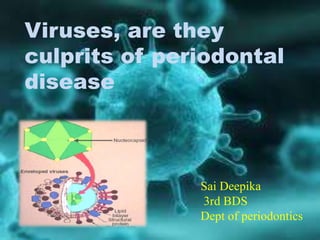
viruses in periodontal disease
- 1. Viruses, are they culprits of periodontal disease Sai Deepika 3rd BDS Dept of periodontics
- 2. Contents Introduction Herpes viruses herpes simplex ebstein-barr virus human cytomegalovirus Human immunodefiency virus Human papilloma virus Conclusion
- 3. Introduction Periodontal diseases are multifactorial in nature and many etiological agents are suggested to play a role in their etiopathogenesis. Until recently, specific bacteria were considered the major pathogens for the disease. The current evidence strongly suggests the presence of many strains of viruses in the periodontal environment. Periodontal disease gingivitis periodontitis
- 4. Various viruses like HIV, Herpes simplex viruses, human papilloma viruses, ebstein bar viruses, cytomegalo viruses, Entero virus species Coxsacki virus play an important role in periodontal diseases
- 5. Herpes viruses Herpes viruses can lead to the development of severe types of periodontitis, and outlines potential mechanisms by which it contributes to periodontal tissue breakdown. Data in the literature suggest an increased frequency of detection of specific members of the Herpes viridae family, such as EBV-1, HCMV, and herpes simplex virus (HSV) in various forms of periodontal disease.
- 6. Mechanism Healthy gingiva Bacterial plaque Gingivitis influx of inflammatory cells containing latent herpesviruses Herpesvirus activation immunosuppression,infection, stress, hormones, etc. Periodontopathic propertycytokines, immunosuppression, direct cytotoxicity,overgrowth of pathogenic bacteria Destructive periodontal disease
- 7. Herpes simplex viruses Infections HSV-1 and HSV-2 are worldwide spread and usually affect skin and mucosa. HSV 1 most commonly effects the oral cavity causing various lesions. Recurrent herpetic gingivostomatitis and chronic herpetic gingivostomatitis in immunocompromised Patients are some of the clinical features of herpes virus infection on periodontium.
- 9. Ebstein–Barr virus Ebstein–Barr virus affects over 90% of humans and is usually transmitted by oral secretions or blood. The virus replicates in epithelial cells or B cells of the oropharynx. Most common symptoms of infectious mononucleosis are fever, lymphadenopathy and pharyngitis. Oral ulcers, palatal petechia and less commonly gingival ulcerations, periodontitis Recurrent aphthous stomatitis, infectious mononucleosis .
- 10. Human cytomegalovirus Human cytomegalovirus infests mainly the t lymphocytes and macrophages. The gB protien in the viron envelop participates in virus- cell interaction and is a major target of immune response. Human cytomegalovirus is the most common cause of congenital and perinatal infections. HCMV infects many different epithelial cells, endothelial cells, smooth muscle cells, mesenchymal cells, hepatocytes, granulocytes and monocyte-derived macrophages and hence causing various periodontal diseases.
- 11. Human immunodefiency virus HIV is associated with the following periodontal conditions: linear gingival erythema (LGE), necrotizing gingivitis (NG), necrotizing periodontitis (NP), and chronic periodontitis HIV causes decrease in CD4 call count which makes the person prone to various bacterial infections effecting periodontium and causing periodontal disease
- 12. Clinical features : Linear gingival erythema is defined as a distinct erythematous band of marginal gingiva with either diffuse or punctuate erythema of the attached gingiva . Linear marginal erythema
- 13. Most studies show a higher prevalence of NG and NP in HIV infected patients than in non-HIV infected patients NG results in the destruction of one or more interdental papillae and remains confined to the marginal gingiva. NP extends beyond the marginal gingiva, involves the periodontal ligament and the alveolar bone, leading to a loss of attachment. NS extends past the mucogingival line into the mucosa and osseous tissue. Necrotizing ulcerative periodontitis
- 15. Human papilloma virus Human papilloma virus (HPV) has also been known to contribute to periodontal infection. Mechanism: HPV causes characteristic cytopathic effects (koilocytosis) and proliferation of epithelial cells. proliferation and migration of the junctional epithelium are a major hallmark of periodontal breakdown and hence causing periodontal disease.
- 16. Theoretically, the junctional epithelium attached to the tooth surface appears to fully serve the cellular functions required by HPV. It has a basal cell like phenotype and does not differentiate. The basal cells are exfoliated through the gingival crevice before differentiation occurs. HPV virus mainly causes oral cancers , tumors and periodontitis. Other less common viruses like picornavirus, enterovirus, coxsackie virus can cause periodontal disease to an extent
- 17. Conclusion Several studies, most of them from the same research group, have demonstrated an association of herpes viruses with periodontal disease. Viral DNA has been detected in gingival tissue, GCF and subgingival plaque from periodontaly diseased sites. In addition markers of herpes viral activation have been demonstrated in the GCF from periodontal lesions. Active HCMV replication in periodontal sites may suggest that HCMV reactivation triggers periodontal disease activity